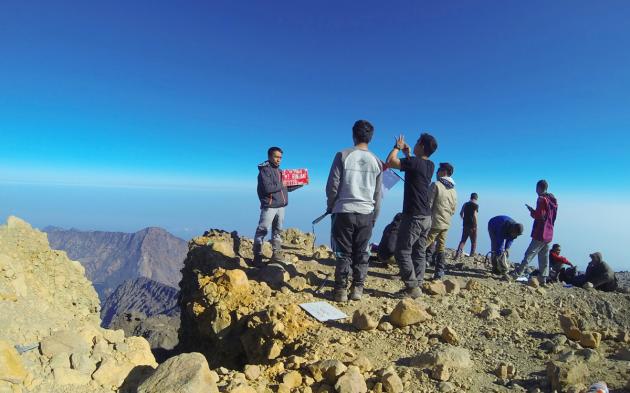Walking in the clouds

An active volcano on the Indonesian island of Lombok, Mount Rinjani is definitely worth the arduous climb
IT IS ALMOST noon and the midday sun is shining mercilessly down on my head so the quiet breeze that occasionally blows across the massive open dry hilly savannah on the foot of the majestic Mount Rinjani in Lombok, West Nusa Tenggara, comes as a welcome relief.
I’m on my own and relishing the quiet walk along the dusty dirt path at the foot of the mountain, recalling the journey I made here several years ago that ended in disappointment.
I was 19 when along with friends, I hiked up Rinjani, aiming to ascend its 3,726 metres-above-sea-level peak. Strong winds around the Crater Rim however forced us to return to our base in Sembalun village.
After resting for two days, we launched another attempt, this time from Senaru village. But we were already exhausted from the first attempt and called off our climb. Going back home, I made a promise to myself that I would come back to Rinjani — and perhaps reach its peak.
So here I am, 18 years later, saying hello to an old and dear friend.
This time I am in a group of 10 – seven Czechs, one German, one French national and myself, the only local. Obviously experienced climbers, they are way in front of me and I find myself struggling to keep a steady pace.
Nazwan, the 35-year-old guide, told us that our first day of climbing would end at the Sembalun Crater Rim, a mere 2,639 metres up.
Starting at 10am from Sembalun village, we have a two-hour lunch break at Tengengean Post, and then set off for the Sembalun Crater Rim. The difficulty comes after Padabalong Post: seven consecutive steep hills in front of us.
Famously known as “The Seven Hills of Regret” as it is here that many trekkers begin to regret their decision to climb Rinjani, I recall ending up in tears on my last visit and almost giving up. Today though, despite the same level of exhaustion, I am simply grateful to be here. Life, it seems, has taught me patience and a greater sense of acceptance.
When I finally reach the Sembalun Crater Rim, the sunset is fading. After a rest, we set off for the summit at 2.45am.
The journey is arduous and I move as much as to keep warm – the temperature is a chilly 3 degrees Celsius – as to reach my target. The soles of my shoes are torn and I can feel volcanic sand and gravel through my socks.
The plan is to catch the sunrise from the summit. Predictably, though, I am still only halfway up the thin Crater Rim as dawn breaks.
Hours later I am still struggling to maintain my pace on the most difficult section of the climb. Every three steps upwards, I go two steps downwards. It’s so frustrating.
I finally reach the Rinjani summit just before 8am and breathe a long sigh of relief that I have finally kept my 18-year-old promise.
The way down is supposed to be easier, but my toes hurt and I am now wearing sandals. That day’s trek is slated to end at Senaru Crater Rim, from where our final descent would begin the next day.
I can’t bear the thought of another gruelling ascent and ask that I be allowed to take the unofficial route down. Between Sembalun and Senaru, the Torean, as it’s known, has a reputation for being a perilous trek.
Nazwan the guide refuses at first, reminding me he is responsible for every one of the group’s members. But after a long argument – I don’t want to slow the group down and I have experienced the Torean route before — he finally agrees, sending one porter – Doni – to accompany me.
So, instead of walking four hours up to Senaru Crater Rim with the rest of the group, I spend the afternoon soaking in the hot spring and hanging out sipping hot coffee.
Passing the enormous Mount Sangkareang (2,588 metres) on our left, we follow a steep narrow path down surrounded by beautiful golden hilly grassland. I slip many times along the trek and pray that my flip-flops will survive until I reach Torean village.
“Hard to the left! Hard to the left!” Doni shouts on the steep parts of the trek and I remember the thrill of crawling along a dangerously rocky and narrow path on the Sangkareang mountain ridge, with an endless ravine on our right.
But the view is stunning and we cross the crystal-clear Lokok Putih sulfuric river without incident.
As we walk down further into the forest and Rinjani’s Crater Rim topography gradually disappears behind us, I silently wave farewell. I don’t make another promise to visit Rinjani again though underneath I know I will be back the moment opportunity presents itself.
RELATED
